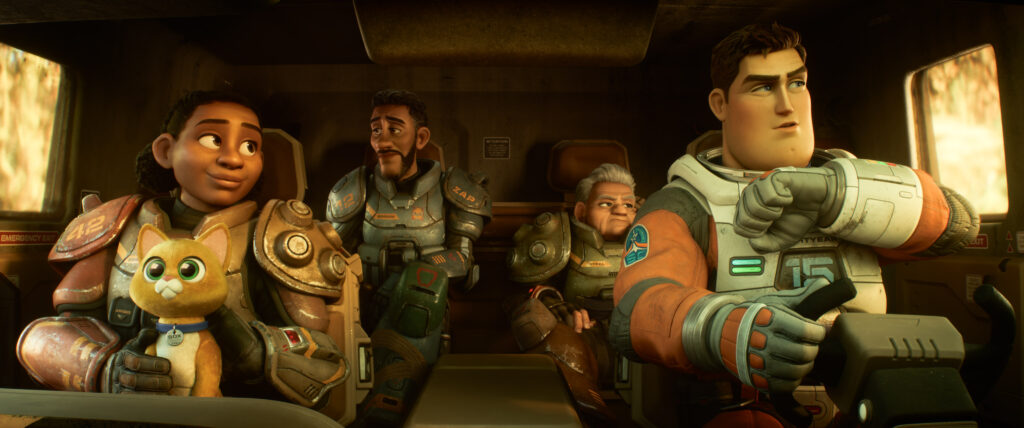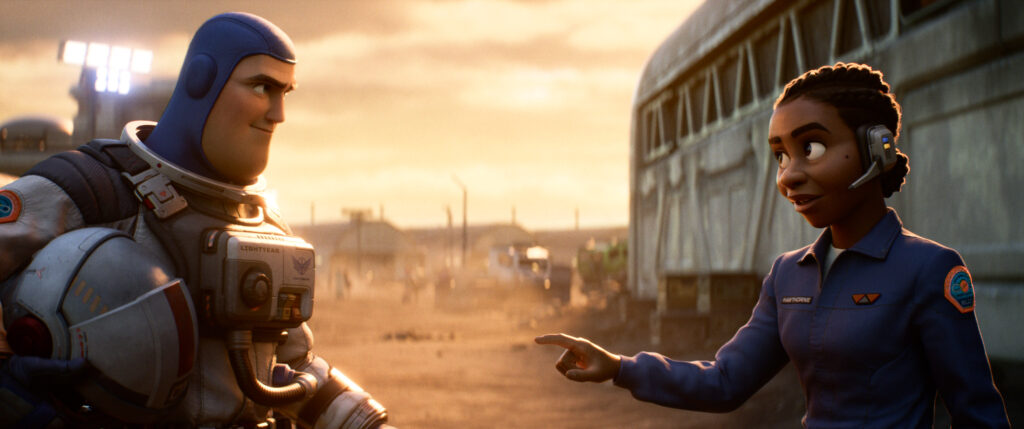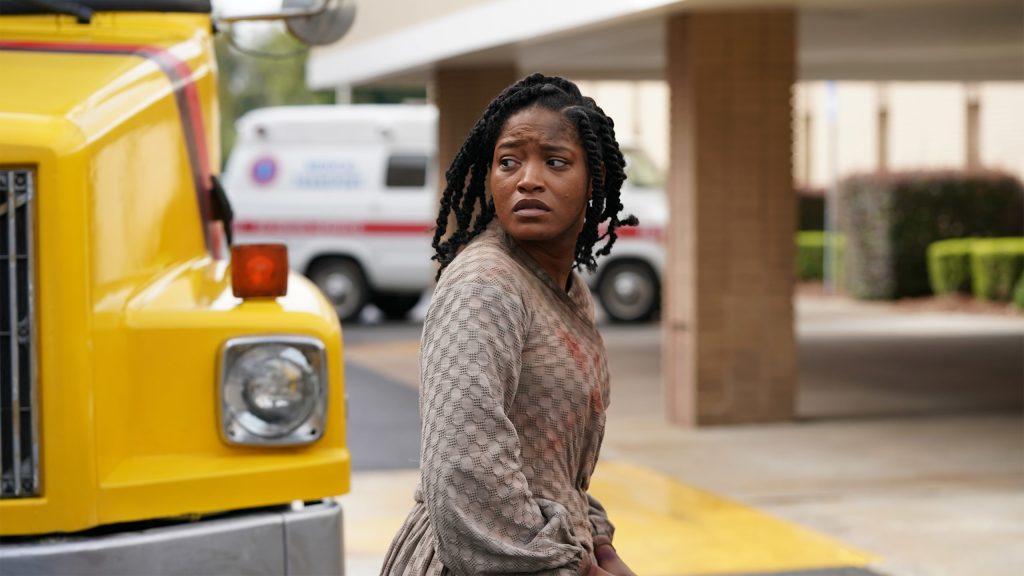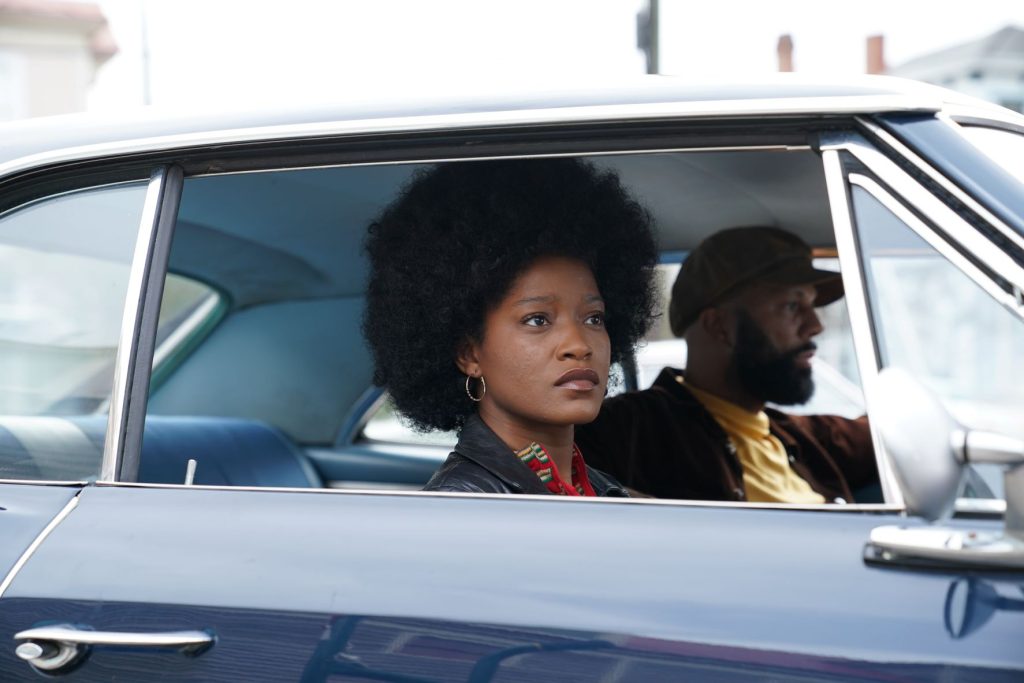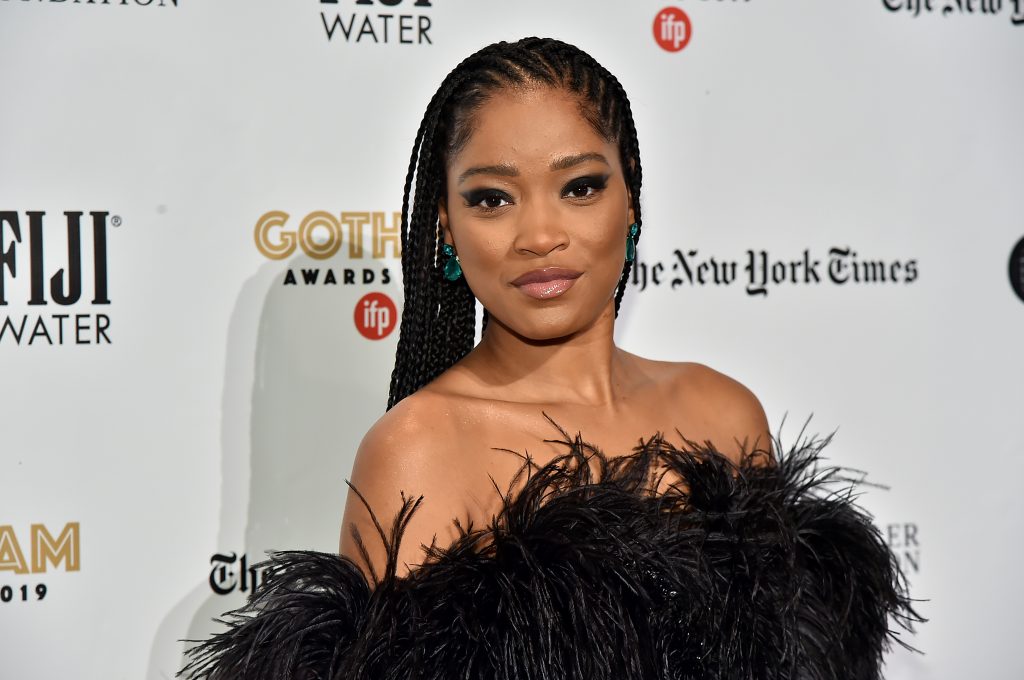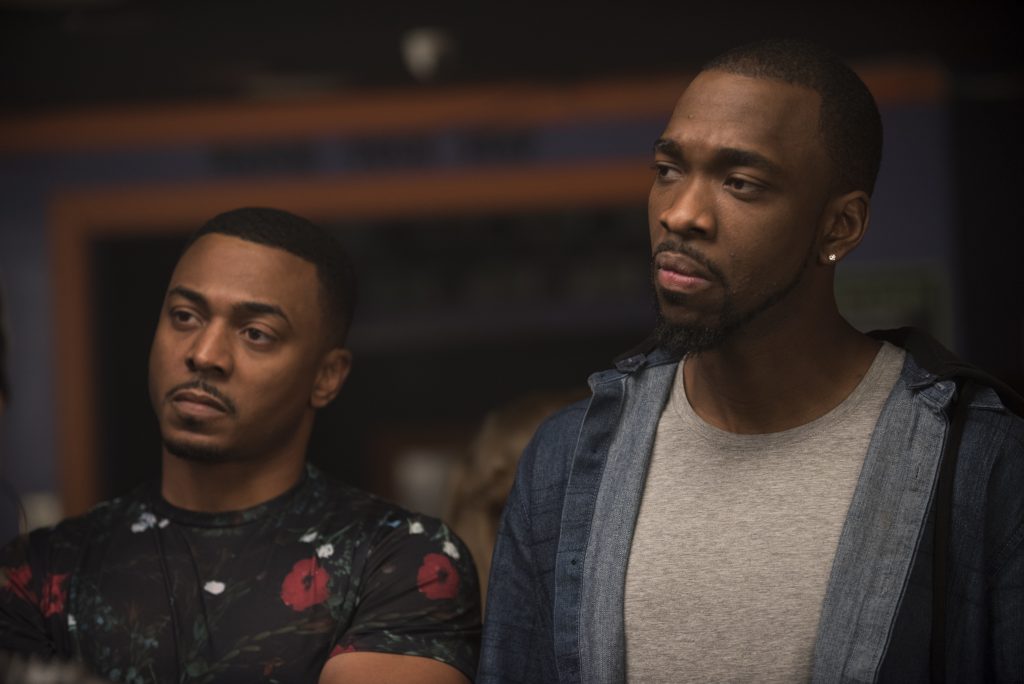July 20, 2022
by Carla Hay

Directed by Jordan Peele
Culture Representation: Taking place in Santa Clarita Valley, California, the sci-fi horror film “Nope” has a racially diverse cast of characters (African American, white, Asian and Latino) representing the working-class and middle-class.
Culture Clash: A brother and a sister, who work together on a horse ranch, join forces with a Fry’s Electronics salesman to visually document an unidentified flying object (UFO) in their area.
Culture Audience: “Nope” will appeal primarily to people who are fans of filmmaker Jordan Peele and stars Daniel Kaluuya and Keke Palmer, but this frequently monotonous and unimaginative movie is an unfortunate case of hype over substance.

Does the sci-fi horror flick “Nope” live up to the hype? The title of this disappointing bore says it all. It’s a rambling, disjointed, self-indulgent mess that does nothing innovative for movies about UFOs. It’s obvious that writer/director/producer Jordan Peele got this movie made without anyone stepping in to question the very weak and lazy plot of “Nope,” and to ask for a screenplay rewrite to make drastic improvements that were desperately needed.
After the memorable originality of the previous two movies that Peele wrote and directed (2017’s “Get Out” and 2019’s “Us”), “Nope” looks like a movie that was made from a half-baked, unfinished screenplay draft that got greenlighted simply because Peele had enormous commercial and critical success with “Get Out” (which won an Oscar for Best Original Screenplay) and “Us.” “Nope” was filmed for IMAX screens, but having a bigger screen doesn’t always make a movie better. Considering all the outstanding and classic movies about UFOs, “Nope” has the substandard story quality of a UFO movie that was thrown together for a fourth-tier cable TV network or a direct-to-video release. Yes, “Nope” is that bad.
One of the reasons why “Nope” fails to live up to the hype is because before the movie’s release, the plot was shrouded in secrecy, as if “Nope” were some kind of masterpiece whose details dare not be leaked out, in order not to reveal a brilliant plot. There is no brilliant plot or even a clever plot twist in “Nope.” It’s just a tedious, badly structured movie about some people who see a UFO in the sky and decide to visually document it because they think it will make them rich and famous.
Too bad it takes so long (not until the last third of the movie) for any real action to take place in “Nope,” which should have been an exciting sci-fi horror film, but it just drags on and on with no real substance. Just because “Nope” has some Oscar winners and the big-budget backing of a major studio, that doesn’t automatically mean that the movie is going to be good. Peele is capable of doing much better movies (as evidenced by “Get Out” and “Us”), but “Nope” just looks like a cynical cash grab from filmmakers coasting on Peele’s previous successes.
Making matters worse, the talented cast members of “Nope” are stuck portraying hollow characters with vague backstories and a lot of cringeworthy or monotonous dialogue. Keke Palmer’s Emerald Haywood character is the only one in “Nope” who comes close to having a fully formed personality, but her character is quickly reduced to being a bunch of one-note soundbites and wisecracks. Everyone else in “Nope” is written as an incomplete sketch.
Characters in “Nope” end up working together in implausible ways. “Nope” also telegraphs way too early which character will have the big “heroic” scene during the inevitable showdown in the movie’s climax. The movie’s visual effects are adequate, but definitely not spectacular for a movie concept of this scope. Intriguing subplots are dangled in front of the audience, only to be left hanging. And many of the action scenes have some horrifically subpar editing.
And why is this movie called “Nope”? It’s because during certain scenes that are supposed to be scary, one of the characters says, “Nope,” as in, “No, I’m not having this right now.” It’s supposed to be an engaging catch phrase, but it’s really very tired and unoriginal. Most of the so-called “comedy” in “Nope” is fleeting and often falls flat.
An early scene in “Nope” (which takes place in California’s Santa Clarita Valley) shows Emerald Haywood and her older brother OJ Haywood (played by Daniel Kaluuya) on the set of a TV commercial, where they have been hired as animal wranglers. OJ and Emerald have inherited a horse ranch called Haywood Ranch (in the desert-like Agua Dulce, California) from their deceased father Otis Haywood Sr. (played by Keith David, who has a flashback cameo), a groundbreaking horse wrangler who worked on a lot of Hollywood productions. The Haywoods rent out their horses in a family business called Haywood Hollywood Horses.
The siblings’ mother is not mentioned. Don’t expect to find out how long Otis has been dead. Don’t expect to find out why OJ and Emerald have a ranch with about 10 horses, but they’re the only workers on the ranch. (It’s very unrealistic.) Don’t expect to find out if OJ and Emerald really love their ranch jobs or if they’re just doing it out of family obligation. These are some of the many reasons why “Nope” is so frustratingly shallow and poorly written.
On this particular TV commercial (what the commercial is for is never stated in “Nope”), OJ and Emerald have a black horse named Lucky that has been hired to be in the commercial. The horse is being filmed indoors, in front of a green screen. It’s OJ and Emerald’s job to handle the horse and tell people on the set how to interact with the horse.
OJ and Emerald have opposite personalities. OJ is quiet and introverted. Emerald is talkative and extroverted. Kaluuya, who gave a compelling Oscar-nominated performance in “Get Out,” plays a dreadfully dull character in “Nope.” It’s not Kaluuya’s fault. The character was written that way. And it’s a waste of Kaluuya’s talent.
Emerald is so talkative that she gives a mini-lecture to all the assembled cast and crew members about how the very earliest moving picture is considered to be Eadweard Muybridge’s 1887 loop of cards titled “Animal Locomotion, Plate 626,” the very first scientific study to use photography. “Animal Locomotion,” an early example of chronophotography, featured an unidentified black man riding on a horse.
Emerald then asks the assembled group if they happen to know the name of the man who rode the horse. No one knows, of course. Emerald than proudly states that the man was actually an ancestor of Emerald and OJ, and his last name was also Haywood. There’s no way to verify if what Emerald is saying is true. And the people on this set don’t really seem to care. They just want to get the job done for this commercial.
There are some racial undertones to the cast and crew’s bored reaction to Emerald’s story, since OJ and Emerald are the only African American people on this set. It might be Peele’s way of showing that people who aren’t African American are less inclined to care about African American history. OJ seems slightly embarrassed and annoyed that Emerald is telling this story to people who obviously aren’t interested. Emerald also uses this moment to announce to everyone that she’s available for work as an actor, filmmaker, stunt person and singer.
The cinematographer for this commercial is a jaded elderly man named Antlers Horst (played by Michael Wincott), who will end up encountering OJ and Emerald again much later in the movie. Also on the set is actress Bonnie Clayton (played by Donna Mills), whose job is to interact with the horse. Although it’s nice that the “Nope” filmmakers hired former “Knot’s Landing” star Mills for this movie, because she doesn’t get enough work that she deserves, her role really is a cameo, with screen time of less than five minutes.
Emerald and OJ advise everyone on the set to remain calm around Lucky. And it’s at that moment you know things are going to go wrong. Lucky gets nervous about something and starts bucking and lunging in a way that’s dangerous. Because the horse is deemed unfit to be on this set, Emerald and OJ are fired. OJ says that they need this job, but the decision has been made to let them go.
OJ and Emerald then go to Jupiter’s Claim, a California Gold Rush theme park owned and operated by Ricky “Jupe” Park (played by Steven Yeun), a former child star who often acts as a show emcee at this theme park. Jupe is married and has three sons, ranging in ages from about 7 to 12 years old. Jupe’s wife Amber Park (played by Wrenn Schmidt) works with him at Jupiter’s Claim. Their sons Colton Park (played by Lincoln Lambert), Phoenix Park (played by Pierce Kang) and Max Park (played by Roman Gross) have brief appearances in the movie.
OJ decides that he’s going to sell Lucky to Jupe. Emerald is upset by this decision, but OJ reassures her that he plans to buy Lucky back when he has the money to do so. It’s a transaction that OJ and Jupe have done before, so Jupe is aware that his ownership of Lucky will probably be temporary.
Jupe knows about OJ’s financial problems and has been offering to buy OJ and Emerald’s ranch, but so far the offer has been declined. Later in the movie, OJ explains he’s not willing to give up Haywood Ranch because he wants to continue his father’s legacy: “He changed the industry. I can’t just let that go.”
It’s during this horse-selling transaction scene that viewers find out a little bit more about OJ and Emerald. OJ is the main caretaker and operator of the ranch. Emerald considers the ranch to be her “side job,” but she doesn’t really have a permanent career, because she jumps around from job to job as her main source of income. Emerald is also the “partier” of these two siblings: She likes to vape and is open about her fondness of smoking marijuana.
The siblings have some unspoken resentment about responsibilities for the ranch, as well as unresolved feelings about the death of their father. Later in the movie, Emerald confesses to OJ that when they were children, she was jealous when their father asked OJ to help train a Haywood family-owned horse named Jean Jacket, a horse that Emerald says she hoped would be the very first horse she would train and own. Get ready to roll your eyes: Later in the movie, the outer space entity in “Nope” is given the name Jean Jacket.
Emerald is openly queer or a lesbian, because she often dates women she works with or meets through her jobs. OJ mildly scolds Emerald about it because he thinks it’s unprofessional for her to mix her love life with her work life. Emerald brushes off his concerns. Meanwhile, as an example of how “Nope” doesn’t have a lot of character development, nothing is ever mentioned about OJ’s love life or anything about his life that isn’t about the ranch.
As for Jupe, he has an interesting background that is sloppily explored in “Nope.” Jupe’s main claim to fame as a child actor in the 1990s was playing a supporting character named Jupiter in a big hit movie called “Kid Sheriff” and then starring in a TV comedy series called “Gordy’s Home,” which was on the air from 1996 to 1998. In the meeting that Jupe has with OJ and Emerald, Jupe shows them a secret room where he keeps “Kid Sheriff” memorabilia. Jupe proudly mentions that a Dutch couple paid him $50,000 just so the couple could spend a night in this room.
Jupe’s experience with “Gordy’s Home” is what led him to quit being an actor. In “Gordy’s Home,” Jupe played an adopted child in a white family of two parents and an older sister. The family had a pet chimp named Gordy, and a lot of the show’s comedy revolved around this monkey’s antics.
Something shocking and traumatic happened one day while filming an episode of “Gordy’s Home.” And as an adult, Jupe still doesn’t want to talk about it, based on how he reacts when it’s quickly mentioned in a conversation between Jupe and OJ. What happened on that fateful day on the set of “Gordy’s Home” was big news. And this incident is shown as a flashback in “Nope.”
However, the way this flashback is dropped into “Nope” is so random and out-of-place, it’s very mishandled. This flashback is then never referred to or explained again in the movie. It’s a suspenseful scene, but it almost has no bearing on the overall story of “Nope” and seems to be in the movie only for some shock value.
It doesn’t take long for “Nope” to show the UFO (a generic-looking saucer-shaped object), which is first seen by OJ when he’s at the ranch. After he tells Emerald about it (his description is vague, because OJ is written as someone who’s barely articulate), Emerald immediately thinks they should try to film the UFO so they can get rich and famous from the footage.
And so, Emerald and OJ go to Fry’s Electronics to stock up on video surveillance equipment. Fry’s Electronics and the company logo get so much screen time in “Nope,” it’s brand placement overload. (All of this promotion of Fry’s Electronics in “Nope” is not going to do Fry’s Electronics much good anyway. In real life, Fry’s Electronics went out of business in 2021, the same year that “Nope” was filmed.)
At the store, OJ and Emerald meet sales clerk Angel Torres (played by Brandon Perea), who is overly talkative and curious about why OJ and Emerald are getting so much video surveillance equipment. Angel correctly guesses that it’s because OJ and Emerald want to film a UFO, but OJ and Emerald deny it. Angel also happens to be the Fry’s employee who delivers the equipment and helps install it. And you know what that means: Angel eventually finds out the truth, and he teams up with OJ and Emerald in their quest.
Angel is prominently featured in “Nope,” but he’s another example of an underwritten character in the movie. Viewers will learn nothing about Angel except that he was recently dumped by an actress ex-girlfriend named Rebecca Diaz, who was in a relationship with him for four years. Angel overshares this information the first time that he meets OJ and Emerald while lamenting that Rebecca broke up with him to star in a TV series on The CW network. OJ and Emerald don’t care, and neither will viewers of “Nope.”
Angel also goes on a mini-rant about how he doesn’t like how UFOs are now expected to be called UAPs (unidentified aerial phenomena), because he likes the term UFO more. And once again: OJ and Emerald don’t care, and neither will viewers of “Nope.” Angel isn’t too annoying, but he will get on some viewers’ nerves because of his condescending, know-it-all attitude.
Without going into too many details, “Nope” makes some weird decisions on what technology is used to visually document the UFO. Even with a lot of modern digital technology at their disposal, the people in this UFO-sighting group use some very outdated and clunky cameras that require film. The explanation provided is very phony and overly contrived.
Apparently, the “Nope” filmmakers thought it would like cool to have the characters using retro cameras that require film, even though film could be ruined a lot easier than digital footage. It makes no sense, except to add unnecessary hassles for the people trying to visually document this UFO. And yes, there’s a scene where a camera’s film needs to be inconveniently changed at a pivotal moment.
It should come as no surprise that the alien life form that’s hovering in the sky abducts living beings. The way this alien life form looks is not very original at all. However, even these abduction scenes are handled in an idiotic way in “Nope.” And none of it is truly terrifying.
There’s a scene where 40 people are abducted at the same time, but the abduction is mostly suggested and shown in brief flashes. This mass abduction makes the news. However, “Nope” has no realistic depictions of the huge investigations and military reactions that would ensue, or how much of a circus the abduction scene would be for the media and curiosity seekers.
When Emerald goes back to the abduction scene later in the movie, the place is deserted, and she has free access to the place, with no law enforcement, military, security personnel or media in sight of this notorious crime scene. It’s all just so stupid. And it’s very easy to predict which characters will survive during this mess, based on how often and how close the alien life form “chases” certain characters out in open fields (making them easy targets), but the alien life form never abducts them.
But the worst plot hole of all is that viewers are supposed to believe that for a certain period of time, only OJ and Emerald have witnessed this giant UFO that appears numerous times in the sky and would actually be seen for miles. It’s as if the “Nope” filmmakers want viewers to think that the only people who can see the UFO in the sky during these times are either at the ranch or looking at the ranch’s closed-circuit live surveillance footage, which Angel does because he’s nosy. It’s pathetic storytelling.
“Nope” also has pretentiously titled chapters, such as “Ghost” (named after the ranch’s white horse that doesn’t do anything but run away and come back a few times), “Clover,” “Gordy” and “Jean Jacket.” There’s not a consistent through line for these chapters, which are as haphazard as a mismatched jigsaw puzzle. The chapter titled “Gordy” is the one that shows the tragic incident that happened on the set of “Gordy’s Home.”
“Nope” has a few moments that effectively build tension for viewers to wonder what’s going to happen next. (There’s also a fake jump scare scene that would have been more interesting if it were real jump scare in the story.) But as a horror movie, “Nope” fails miserably to be frightening. There are parts of this movie that are so boring, some viewers will fall asleep. Don’t expect “Nope” to give a reason or a purpose for any life forms that come from outer space. In fact, don’t expect “Nope” to have a reason to exist other than to make blockbuster money and fool people into thinking that it’s a high-quality, entertaining movie.
Universal Pictures will release “Nope” in U.S. cinemas on July 22, 2022.

